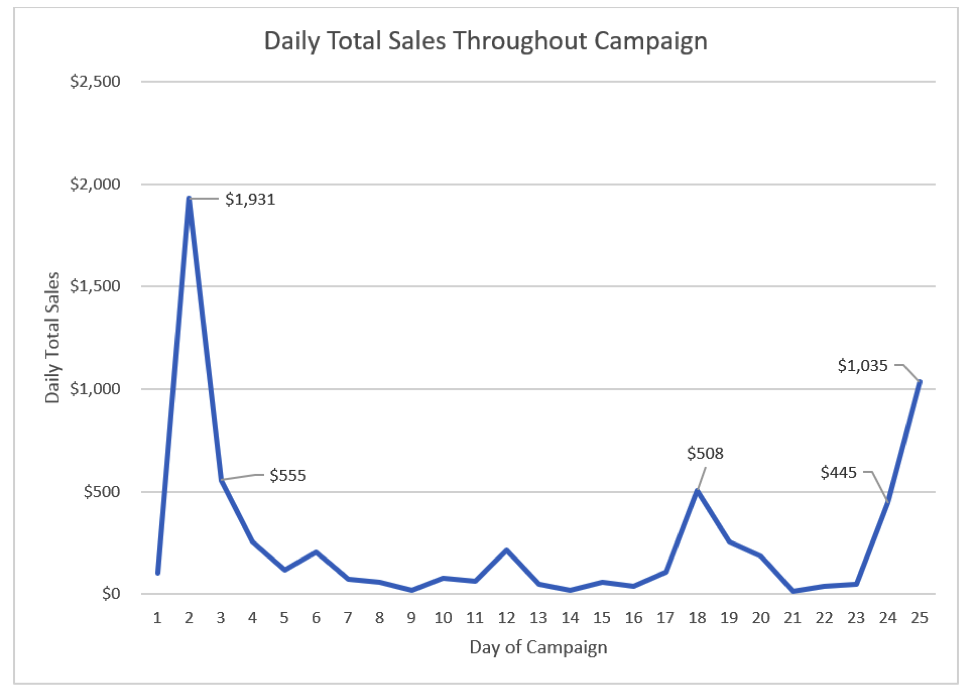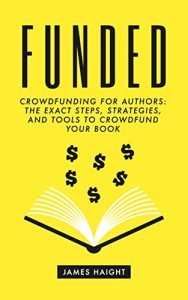
Today’s guest post is by James Haight, who is currently awaiting the launch of his debut novel, Jack & Coke, and spends his time helping other authors navigate the crowdfunding landscape at The Book Crowdfunding Academy.
Crowdfunding a book is challenging, time consuming, and requires an author to expend a tremendous amount of social capital. Authors should not take this decision lightly.
I found this out first-hand when I set out to crowdfund my debut novel Jack & Coke. It was a grueling process. Thankfully, by the time it was all said and done, I had exceeded my expectations. As an unknown author, I was able to pre-sell 334 copies of my book, raise $6,475, and bring my book to market. The outcome thrilled me, but it certainly wasn’t easy.
I firmly believe that any author can successfully launch their book through crowdfunding if they are willing to put in the effort. However, it may not be the right path for everyone. Below I’ve shared the biggest insights from my experience that lay out the case for and against the decision to crowdfund your book.
Insight #1: Crowdfunding Makes It Easier to Sell Your Book
Crowdfunding is hard, but an individual book sale is never easier than when you are in the midst of your campaign.
That’s because crowdfunding lets people do more than just buy your book. With crowdfunding, your backers are the reason your book gets to exist. Every pre-order helps to make your dream come true, and that’s a powerful selling tool. It’s human nature to want to be a part of something special and crowdfunding lets you tap into this desire.
Further, authors can leverage crowdfunding to build excitement about more than just their book. They can build an audience that is excited about the book’s journey as well. Crowdfunding allows authors to incorporate creative benefits for backers. These opportunities are what make crowdfunding so exciting, and they can range from the extreme, like naming a character, to the more traditional, such as a signed copy or a dinner date with the author. These special (and limited) bonuses are often enough to transform a casual observer into a paying customer.
Not only that, but crowdfunding inherently creates a sense of urgency. One of the most difficult obstacles to overcome is convincing someone to “buy now” rather than to wait and buy it from Amazon later. Because crowdfunding campaigns have a time limit, it invokes an urgency that authors can convert into sales.
Insight #2: Crowdfunding Takes Serious Preparation (And Some Numbers to Prove It)
If you talk to anyone who has run a successful crowdfunding campaign (regardless of product), they will all tell you the same thing. Success is determined before the campaign launches.
The workload for campaigning is front loaded. About 80% of the total effort happens before you ever flip the switch to make your campaign live. Authors must remember that everything is dependent on a successful launch day.
Crowdfunding is a momentum game. People like being a part of successful projects. For the same reasons that sports teams draw bigger crowds when they are winning than when they are losing, people are more likely to contribute to your campaign if it looks like it’s going to hit your goals.
Achieving a critical mass on launch day is paramount to success. This means that success is dependent on weeks of hustling, building buzz, and calling in well-timed favors from friends.
You will need to spend the weeks leading up to your campaign nurturing excited fans along the path to becoming paying customers.
I dedicated a total of two months to managing my campaign. I spent the first month in preparation (planning a launch party, building an email list, etc) and the second month actually running the live campaign.
If you are skeptical as to if it’s necessary to spend a month prior to your campaign, then look no further than the actual sales data from my experience with Jack & Coke.
Figure 1: Daily Total Sales

As you can see, the bulk of sales came on launch day. (Note: Day 2 was my official launch day, but some fans found out it was available a few hours before midnight).
To emphasize this point even further look at the below chart. I’ve transformed the data to show the cumulative percentage of total sales over each day of the campaign.
Figure 2: Cumulative Percentage of Total Sales

This chart shows that launch day accounted for 30% of the campaign’s total sales. Not only that, but 50% of the campaign’s sales were generated by day 7!
This pattern of heavy initial sales followed by a trickle of sales until the last day is a typical pattern across crowdfunding campaigns. Early sales lead to future sales. If you want to reach your fundraising goals, then you must put in the prep work to get as many people to your launch as possible.
Insight #3: Your Pitch Video Is Not About Your Book
Pitch videos are the cornerstone of a successful crowdfunding campaign. However, author’s make a mistake when they think that their pitch video is about their book. It’s not. It’s about what you can provide to your audience.
Of course, you need to address what your book is about, but that’s not what is going to turn a viewer into a backer.
For fiction books, an author must create an emotional connection. You must create excitement about the journey of your book, and backers must be excited to help make your book exist.
For nonfiction authors, especially in the self-help/business space, it’s all about the transformation your book will provide. For example, if your book will help your audience eat healthier or be a more effective CEO then you need to convince them of this? If your audience believes in the transformation you are offering, then they will happily sign up for campaign.
When it’s all said and done, a good pitch video should:
- Create an emotional connection with the audience
- Create a sense of urgency for the audience to contribute now
- Articulate what your backers will get for their money (i.e. the satisfaction of a limited edition signed copy, or the prospect of a personal transformation).
For a discussion about how to create the perfect pitch video, check out our full analysis here.
Insight #4: Fees Take a Chunk Out of Earnings
Everyone loves to talk about how much money people can raise from crowdfunding. But no one likes to talk about the fees that come along with it. Crowdfunding platforms will charge a fee that is generally a fixed percentage of the money raised.
Each platform will have its own fee structure, but you can generally expect fees ranging anywhere between 5% and 35% of your earnings.
My platform ended up taking a 30% cut of my earnings. As you can see in the chart below, this ended up being a sizable amount of cash.
Figure 3: Crowdfunding Fees
| Copies Sold | Total Earnings | Platform Fees | Payment Fees | Author Earnings |
| 334 | $6,475 | $1,942.50 | $256.78 | $4,275.73 |
 Your goals as an author should dictate the platform that you choose. Those who are dead set on self-publishing may want to search for the platform with the lowest fee. Conversely, authors who are more concerned about working with a specialized platform may be willing to pay a higher fee.
Your goals as an author should dictate the platform that you choose. Those who are dead set on self-publishing may want to search for the platform with the lowest fee. Conversely, authors who are more concerned about working with a specialized platform may be willing to pay a higher fee.
Done right, crowdfunding allows authors to build an audience faster than they ever thought. Just be aware that it’s never as easy as it seems. Crowdfunding favors those who are willing to put in the preparation and those who are unwilling to quit.
If you decide that crowdfunding is right for you, you can join me at The Book Crowdfunding Academy, a community to help guide fellow authors to crowdfunding success. Or, you can check out the ebook that breaks down the exact steps authors need to take to go from zero to funded. It includes email scripts and pitch video examples that you can use in your own endeavor.
James Haight is currently awaiting the launch of his debut novel Jack & Coke and spends his time helping other authors navigate the crowdfunding landscape at The Book Crowdfunding Academy.
He is also the author of the eBook Funded: The Exact, Steps, Strategies, and Tools to Crowdfund Your Book, which outlines exactly what an author needs to do get their book funded.

[…] on October 5, 2017 by Don Massenzio Posted on October 5, 2017 by James Haight | No […]
Thank you for bringing up the fees! The financial aspect of Kickstarter often gets overlooked. Let’s even go further…
You netted: $4,275.73. In the US that would be taxed as regular income. So after taxes your net income from your Kickstarter campaign would be roughly $3K.
You presold 334 copies. Printing and shipping of those paperback books (assuming it’s not ebook only) would run roughly ~$8/book, for a total of $2672. If we assume you spent some money on your Kickstarter campaign (marketing, video editing, etc.) your campaign would just about break-even.
Which is great if you approach this as an opportunity to presell hundreds of copies, get some people excited about your project, and have a much greater chance at getting positive reviews and word of mouth because your backers are far more engaged than the average reader.
It’s less great if you’re looking at Kickstarter as a way to generate funds to produce the book. So authors need to really run the numbers and have a clear idea of what they’re goal is at the getgo.
I couldn’t agree more Alexis. The way books are priced (~$20/book) makes it very difficult to overcome the per unit publishing costs AND the incremental fees of platforms/taxes. Unless an author is able to sell multiple packages at $500+ (Like an exclusive dinner or a training session) then crowdfunding isn’t going to generate profit.
However, as you mention, it is an AMAZING feeling to produce your book without paying money out of pocket and already knowing that you have a few hundred eager fans awaiting its arrival!
Hmmm so that’s a great article and it makes me feel even more convinced that a soft sell at Patreon is a better answer for a time poor – as well as cash poor – author. I have run out of cash and my wonderful and very competitively priced editor has just died and looking at replacements her departure may be a fiscal disaster as well as an emotional one in that the costs of others may double the price of book production.
I wondered about Kickstarter or the like but I know I have neither the following nor the energy that you describe to make it work. Nor the time.
That doesn’t mean I won’t try in future maybe or that I won’t try a Patreon approach have been looking into that for a few welds now. So pleased to have discovered your site. I feel I will make a berry much better effort than I would have done however I try to fund my work. Thank you.
Cheers
MTM
If you can understand any of that after auto correct mangled it.
Could not agree more about the success on launch. It’s absolutely critical to have all the momentum ready to go as the campaign is launched. You can not play catchup once you go live.
[…] Thinking about crowdfunding your project? James Haight has what authors need to know about crowdfunding. […]